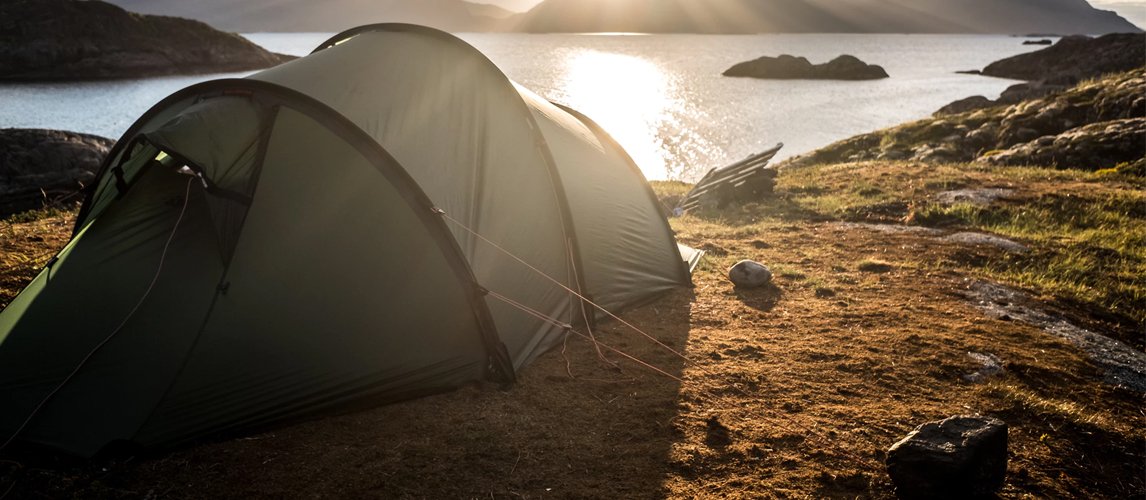There’s nothing worse than being in your tent in the rain and you’re still getting wet! Having a good tent that will keep you dry is often the difference between misery and having a fun camping trip. We get a lot of questions asking what to look for in a tent that can perform in the rain. A quick online search will tell you which tents are best in the rain, but you soon see that everyone has a different opinion based on where they’re from, the size of their wallet, the type of camping they do, the most famous brands, etc. Not sure what tent will do the job? No matter what your budget or purpose, you can choose a tent that can handle the rain and is right for you. Knowing which tent design features and specs to consider will give you the power to decide on the best tent that can handle rain.
WATERPROOF COATINGS
Most tents have coatings applied to the fabric to make them waterproof and stop water getting through. The Hydrostatic Head is measured in mm and generally the higher the number the greater the ‘waterproofness’. For a tent fly a minimum of 1500mm is generally accepted to be waterproof but if expecting heavy rain something around 3000mm or higher is recommended. For tent floors, ratings should be higher as they deal with the pressure of you pushing them down into the ground all the time, something from 3000mm to the max 10,000mm. Note that having high mm ratings is not always required or best for a tent (otherwise everything would be 10,000mm). Look for 3 or 4 season tents. To learn more check out these for more info on waterproof ratings and fabric specs and coatings.
SEAMS
Check that the seams of the tent are sealed to prevent water leaking through. Tents with a polyurethane coating should have a clear strip of tape that has been applied along all of the seams on the underside of the fly. But these taped seams cannot be applied to silicone coated surfaces so you may need to apply a liquid sealant yourself. You will often find tents have one side of the fly coated in silicone and the underside coated in polyurethane with the taped seams applied. Canvas tent seams generally won’t have any problem
DOUBLE WALLED TENTS
Tents with two walls, an outer fly and inner fly, are best suited to the wet conditions. The outer fly is usually waterproof and the inner fly wall is not waterproof but breathable so allows for better air ventilation and less build-up of moisture and condensation inside the tent. Single wall tents are great for their lighter weight and ease of set up but more suited to drier conditions. Get a tent with a full outer fly – some tents have a minimal or three-quarter fly suitable for dry conditions but not really designed for use in heavy rain.
FOOTPRINTS
A footprint is an extra protective layer of fabric that can be laid out underneath the inner tent floor. In the wet, it can also add an extra layer between you and the wet ground stopping any moisture getting through the tent floor. Make sure that the footprint doesn’t extend out from under the floor, catching water and pooling it directly under the floor!
VENTILATION
Rain brings more moisture and humidity. Many people seal up the tent when it’s raining – close all doors, vents and pull the fly down as close to the ground as possible. But by stopping all ventilation, moisture is trapped inside leading to condensation inside the tent. Get a tent that has enough ventilation options and use them … ventilation ports, mesh inner walls, doors that can be left slightly open from top or bottom, fly straps to adjust the gap between fly and ground. Read more about preventing condensation here.
PITCHING THE OUTER FLY FIRST
OK, time to pitch your tent but it’s pouring down. One tent can be set up outer fly first, then taking the inner inside and hooking it up into place. The other’s inner fly is set up first, then the fly is placed over the top and secured. Which tent is drier inside? A lot of tents now come with a footprint that allows the tent to be set up fly first, great in the rain (or an option when no inner tent is needed).
ENTRY POINTS
Make sure that entry and exits are easy, and that when opening the tent not too much rain is going to be falling directly into the inner tent. Consider double entry if getting a 2 person tent so that you can get in and out without crawling over someone.
VESTIBULES
The covered storage areas just outside the inner door are more important when it’s raining. Make sure there’s enough room to keep your packs, boots and gear out of the rain. And even as a last resort option can be used for food prep.
TARPS
Not a tent feature we know, but consider taking a tarp or hootchie along as well. Rigging up a tarp gives you extra protection from the rain and a covered area to cook and get out of the tent. Looking at or asking about these points will help you choose a tent that suits your needs and performs well in wet conditions, minimising effects of the rain and maximising your experience. If you have any other questions about tents and rain then contact us.
Post time: Apr-20-2022











